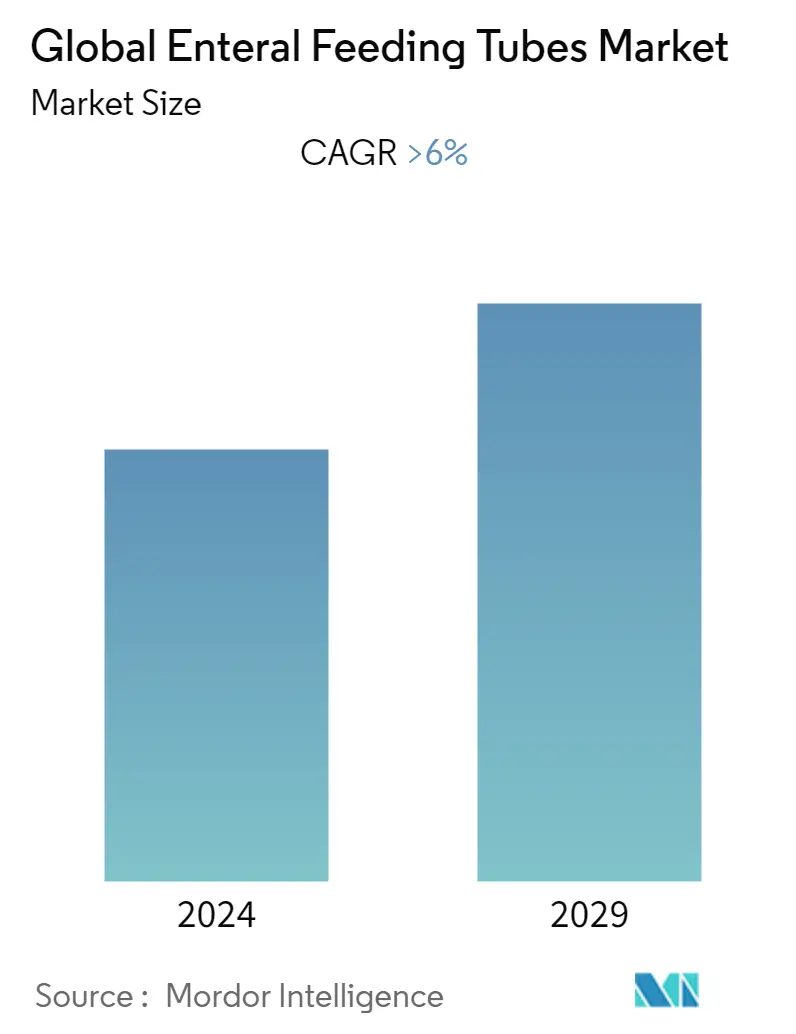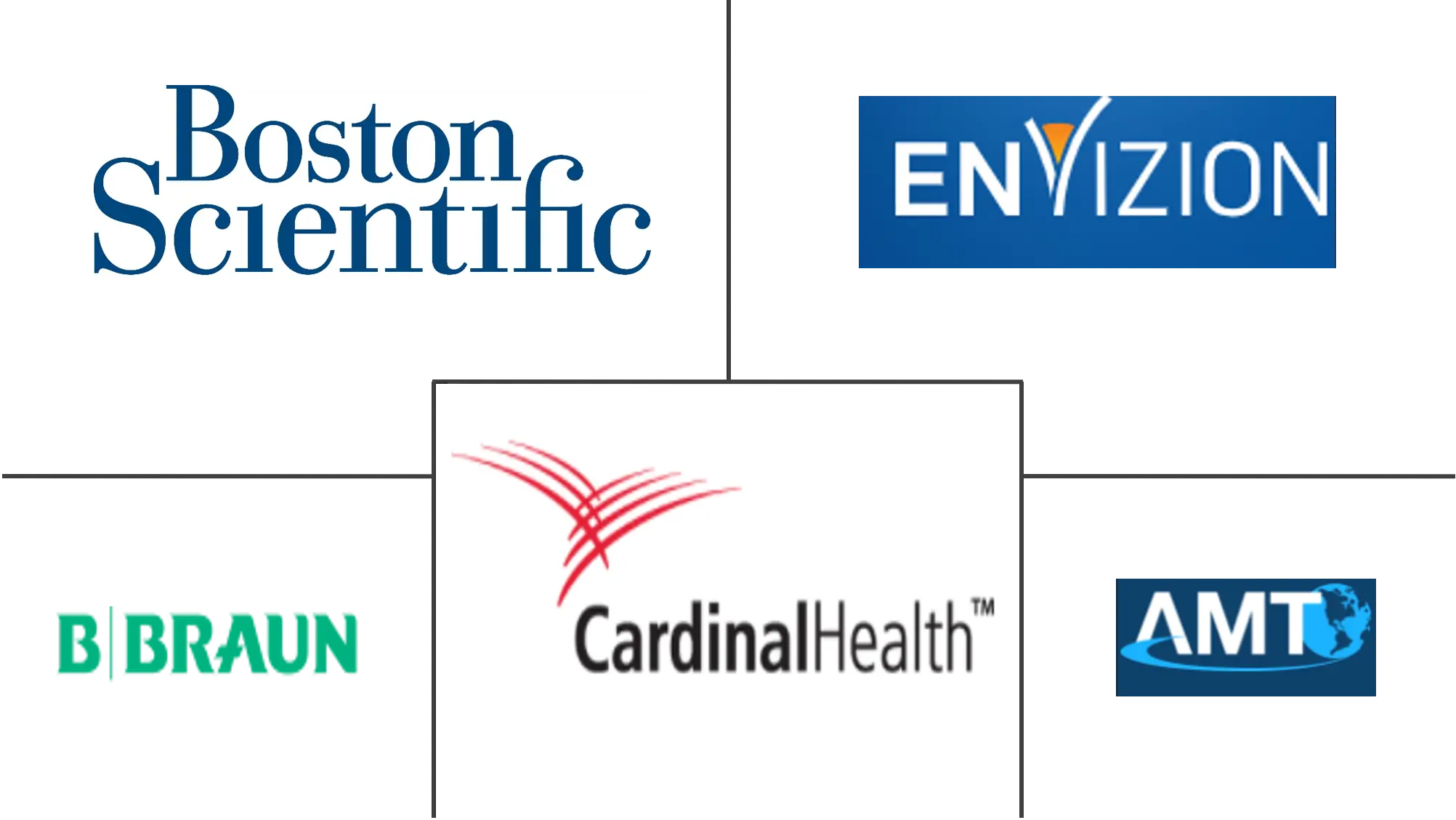Market Size of Global Enteral Feeding Tubes Industry

| Study Period | 2019 - 2029 |
| Base Year For Estimation | 2023 |
| CAGR | > 6.00 % |
| Fastest Growing Market | Asia-Pacific |
| Largest Market | North America |
| Market Concentration | Medium |
Major Players
*Disclaimer: Major Players sorted in no particular order |
Enteral Feeding Tubes Market Analysis
The enteral feeding tubes market is projected to register a CAGR of 6% over the forecast period.
The COVID-19 pandemic has significantly impacted the enteral feeding tube market growth, globally. The intensive care units (ICUs) in hospitals, worldwide, have been witnessing a surge in admissions due to the SARS-CoV-2 induced respiratory failure, leading to the COVID-19 disease. As per a 2020 published report by the American Society for Parenteral and Enteral Nutrition (ASPEN), hospital staff across all the hospitals, worldwide, have been recommended to initiate enteral nutrition to the patients within 24-36 hours of intubation and placement. Thus, the COVID-19 pandemic has increased the need for enteral feeding tubes in hospitals.
The studied market growth can be largely attributed to the factors, such as increasing incidences of chronic disorders, growing prevalence of malnutrition worldwide, and a rise in the number of preterm births. These factors are fueling the demand for enteral feeding tubes.
With increasing incidences of chronic disorders, there is an increased demand for enteral feeding tubes. The nutritional management of patients suffering from disorders, such as Parkinson's disease, Alzheimer's disease, and motor neuron disease, is crucial. In such patients, enteral feeding is a commonly used intervention to provide nutritional support and combat lack of appetite, dysphagia, and physical difficulty in consuming food. As per the Alzheimer's Association report, in 2021, the number of Americans aged 65 years or above suffering from Alzheimer's dementia is 6.2 million, and the number is projected to triple to 12.7 million by 2050. Thus, the increase in incidences of neurological disorders is expected to fuel the need for enteral feeding, thereby, fueling the demand for enteral feeding tubes. Moreover, enteral nutrition is a low-risk and non-invasive therapy and is indicated for patients having a functional gastrointestinal tract as first-line induction therapy. As per a 2020 report by the International Foundation for Gastrointestinal Disorders (IFFGD), 10 to 15% of the population is affected by irritable bowel syndrome, worldwide, including 25 to 45 million people afflicted with the disease in the United States. Thus, with the increase in the incidence of metabolic and gastroenterology disorders, the adoption of enteral feeding is expected to increase, which will boost the demand for enteral feeding tubes.
Additionally, in June 2020, Otsuka Pharmaceutical factory launched a new ENORAS liquid for enteral use (for a feeding tube and oral administration), coffee flavor, and strawberry flavor. Such new product launches are propelling the growth of the market.
However, esophageal ulceration caused by enteral feeding tubes around the gastrostomy site and physical complications such as tube blockage, tube fracture, tube leakage, and mispositioning of the tube is some of the factors impeding the market growth.
Enteral Feeding Tubes Industry Segmentation
As per the scope of the report, enteral feeding can be defined as the delivery of proteins, minerals, other essential nutrient products, and liquefied drugs into the stomach or intestine of the patient via feeding tubes and are used in the management of acute and chronic illness. These feeding tubes are known as enteral feeding tubes and can be inserted through the oral, nasal, or subcutaneous passage. The market is segmented by Product Type (Nasoenteric Feeding Tube, Enterostomy Tube, and Oroenteric Feeding Tube), Patient Type (Adult, Pediatric), Application Type (Oncology, Neurology, Gastroenterology, Metabolic Disorders, Hepatology, and Other Applications), End-user (Hospitals, Ambulatory Surgical Centers and Others) and Geography (North America, Europe, Asia-Pacific, Middle East & Africa, and South America). The market report also covers the estimated market sizes and trends for 17 different countries across major regions, globally. The report offers the value (in USD million) for the above segments.
| By Product | |
| Nasoenteral Feeding Tube | |
| Enterostomy Tube | |
| Oroenteric Tube |
| By Patient Type | |
| Adults | |
| Pediatric |
| By Application | |
| Oncology | |
| Neurology | |
| Gastroenterology | |
| Metabolic Disorders | |
| Hepatology | |
| Other Applications |
| By End User | |
| Hospitals | |
| Ambulatory Surgical Centers | |
| Other End Users |
| By Geography | ||||||||
| ||||||||
| ||||||||
| ||||||||
| ||||||||
|
Global Enteral Feeding Tubes Market Size Summary
The enteral feeding tubes market is poised for substantial growth, driven by an increasing demand for nutritional support in patients with chronic disorders, malnutrition, and preterm births. The COVID-19 pandemic has further accelerated this demand, as hospitals worldwide have had to prioritize enteral nutrition for patients requiring intubation. The market's expansion is supported by the rising prevalence of neurological and gastroenterological disorders, where enteral feeding serves as a critical intervention. Additionally, the introduction of new products, such as Otsuka Pharmaceutical's ENORAS liquid, is contributing to market growth. However, challenges such as esophageal ulceration and physical complications related to tube use may impede market progress.
North America, particularly the United States, is expected to be a significant contributor to market growth, fueled by the high incidence of chronic disorders and a large number of surgical procedures requiring enteral nutrition. The presence of major manufacturers and high healthcare expenditure further bolster the market in this region. The market is characterized by a few dominant players, including B Braun Melsungen AG and Boston Scientific Corporation, who are focusing on technological advancements and strategic alliances to enhance their market positions. The oncology application segment is anticipated to witness notable growth due to the increasing need for nutritional support in cancer patients, particularly those with head and neck cancers.
Global Enteral Feeding Tubes Market Size - Table of Contents
-
1. MARKET DYNAMICS
-
1.1 Market Overview
-
1.2 Market Drivers
-
1.2.1 Increasing Incidences of Chronic Disorders
-
1.2.2 Growing Prevalence of Malnutrition Worldwide
-
1.2.3 Rise in Number of Preterm Births
-
-
1.3 Market Restraints
-
1.3.1 Complications Associated with the Enteral Feeding Tubes
-
-
1.4 Industry Attractiveness - Porter's Five Forces Analysis
-
1.4.1 Bargaining Power of Buyers/Consumers
-
1.4.2 Bargaining Power of Suppliers
-
1.4.3 Threat of New Entrants
-
1.4.4 Threat of Substitute Products
-
1.4.5 Intensity of Competitive Rivalry
-
-
-
2. MARKET SEGMENTATION (Market Size by Value-USD million)
-
2.1 By Product
-
2.1.1 Nasoenteral Feeding Tube
-
2.1.2 Enterostomy Tube
-
2.1.3 Oroenteric Tube
-
-
2.2 By Patient Type
-
2.2.1 Adults
-
2.2.2 Pediatric
-
-
2.3 By Application
-
2.3.1 Oncology
-
2.3.2 Neurology
-
2.3.3 Gastroenterology
-
2.3.4 Metabolic Disorders
-
2.3.5 Hepatology
-
2.3.6 Other Applications
-
-
2.4 By End User
-
2.4.1 Hospitals
-
2.4.2 Ambulatory Surgical Centers
-
2.4.3 Other End Users
-
-
2.5 By Geography
-
2.5.1 North America
-
2.5.1.1 United States
-
2.5.1.2 Canada
-
2.5.1.3 Mexico
-
-
2.5.2 Europe
-
2.5.2.1 Germany
-
2.5.2.2 United Kingdom
-
2.5.2.3 France
-
2.5.2.4 Italy
-
2.5.2.5 Spain
-
2.5.2.6 Rest of Europe
-
-
2.5.3 Asia Pacific
-
2.5.3.1 China
-
2.5.3.2 Japan
-
2.5.3.3 India
-
2.5.3.4 Australia
-
2.5.3.5 South Korea
-
2.5.3.6 Rest of Asia Pacific
-
-
2.5.4 Middle-East and Africa
-
2.5.4.1 GCC
-
2.5.4.2 South Africa
-
2.5.4.3 Rest of Middle-East and Africa
-
-
2.5.5 South America
-
2.5.5.1 Brazil
-
2.5.5.2 Argentina
-
2.5.5.3 Rest of South America
-
-
-
Global Enteral Feeding Tubes Market Size FAQs
What is the current Global Enteral Feeding Tubes Market size?
The Global Enteral Feeding Tubes Market is projected to register a CAGR of greater than 6% during the forecast period (2024-2029)
Who are the key players in Global Enteral Feeding Tubes Market?
Cardinal Health, Boston Scientific Corporation, ENvizion Medical Inc., Applied Medical Technology Inc. and B Braun Melsungen AG are the major companies operating in the Global Enteral Feeding Tubes Market.

